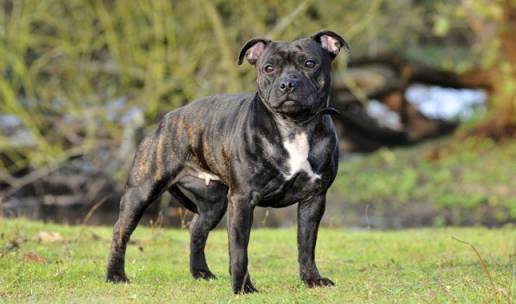Connect with a verified veterinarian in minutes. Licensed vets are available 24/7 to answer your questions. No need to worry about your furry family member.
No dog owner wants to consider euthanizing their dog. There’s nothing harder than to say goodbye to your canine companion. No matter the cause, euthanasia is a challenging topic to discuss or even consider.
In this article, we’re going to cover a condition called tracheal collapse and how to know when it’s time to put your dog down due to this condition.
What Is Tracheal Collapse?
Before we get into information about this condition, it’s first essential to understand what a trachea is and what it does. The trachea is a tube that connects a dog’s throat to his lungs. The tube is flexible and is made up of c-shaped rings of cartilage. The cartilage rings work to keep the trachea open to allow air into and out of the lungs.
Tracheal collapse is a condition that causes progressive breathing difficulties in dogs. The condition begins to develop when the rings of cartilage begin to collapse. This is what makes it difficult for the dog to breathe. Their windpipe is collapsing.
In dogs with the condition, the rings of cartilage begin to weaken and flatten out. As the trachea stretches, the cartilage rings become flatter and flatter, ultimately ending in trachea collapse. The collapse can go all the way into the bronchi in the lungs, making breathing even more difficult.
It’s not known what causes the trachea to collapse in this manner. However, in some dogs, this condition may be a genetic disorder. That means this is a condition a dog has at birth.
As a dog’s trachea starts to collapse, the dog may develop a cough that sounds like a honking sound. The sound is produced as air is pushed through the collapsing trachea.
Tracheal collapse can vary in severity, depending on how weak the cartilage rings become.
Other Risk Factors for Tracheal Collapse in Dogs
There are other factors that can increase the risk of a dog developing this condition, including:
- Certain toy or small breed dogs are prone to developing this condition
- Yorkshire Terriers
- Pugs
- Pomeranians
- Toy Poodles
- Chihuahuas
- Age of dog: dogs are more prone to developing this condition when they are middle-aged or older dogs
- Overweight or obese dogs
- Dogs that live with smokers in the home
- Dogs with chronic respiratory disease
- Dogs who have chronic heart disease
- Dogs with Cushing’s disease
It’s thought that these conditions can lead to a weakening of the cartilage rings in the trachea over time. The result may eventually develop into complete tracheal collapse at some time in the future.

Review symptoms, medications & behavior to keep your pets healthy with a Vet Online in just minutes.
Ask a Vet Live NowClassification of Tracheal Collapse in Dogs
Tracheal collapse is categorized into four grades of severity:
- Grade 1: the cartilage is still normally shaped; however, the cells that form the tracheal lumen are reduced by about 25% (tracheal lumen support the dog’s trachea) (the early form of tracheal collapse)
- Grade 2: the tracheal lumen is reduced by about 50%, and the cartilage has begun to partially flatten
- Grade 3: the tracheal lumen is reduced by about 75%, and the cartilage is almost completely flat
- Grade 4: the tracheal lumen is completely collapsed, and the cartilage is completely flat (the last form of tracheal collapse)
Symptoms of Tracheal Collapse in Dogs
You may notice these symptoms of your dog develops tracheal collapse:
- Chronic coughing (may worsen with exercise, excitement, eating, and drinking)
- Rapid breathing
- Breathing abnormality
- Difficulty breathing
- Low energy
- Bluish tinge to gums
- Fainting
- Coughing if you pick your dog up or apply pressure to his neck
- Vomiting/gagging/retching accompanied with coughing
- Wheezing
- Exercise intolerance
Tracheal collapse usually results in a non-productive cough and is not accompanied by a fever. The dog may have trouble breathing when he eats, drinks, exercises, becomes excited, or when the temperature is too warm or too cold. Each of these activities can lead to breathing difficulties.
The dog may have a honking cough that worsens with activity or even at night. What’s more, the cough may even be triggered by the dog pulling on his collar or leash, which puts pressure on the neck. The cough may also worsen in humid or hot weather, as well as in cold weather.
In addition, the dog may develop respiratory distress. These are times when breathing will be challenging and can last as long as several minutes. Eventually, breathing will become easier again.
When the dog begins to cough or breath harder, the trachea can fall more inward than normal, which can lead to sudden onset of symptoms.
If you notice any of these symptoms in your dog, then call the vet right away. Your dog could have a severe tracheal collapse.
Is Tracheal Collapse a Medical Emergency?
We’re not able to provide a clear answer, as it depends on the severity of the dog’s symptoms. The condition will definitely become life-threatening if it’s not caught and treated early.
What’s more, each time the dog experiences these breathing issues, the inflammation in the trachea and lungs will increase. This can eventually lead to complete obstruction of the dog’s airways.
If this happens, the dog will have an extremely difficult time breathing. They could even collapse just trying to breathe. When a dog is in this state, then it is definitely a medical emergency.
How Is Tracheal Collapse in Dogs Diagnosed?
This condition must be diagnosed by a veterinarian. When you take your dog to see the vet, they will question you about your dog’s health history and then conduct a complete physical exam.
The vet may run some tests to help make a definitive diagnosis, which may include:
Tracheoscopy (or bronchoscopy): this is usually done under general anesthesia. The vet uses a scope, which has a camera on its end, which is used to examine the trachea.
Chest X-ray: is done to help rule out other conditions. Chest X-rays can also show whether the trachea has collapsed and if the collapse is closer to the throat or in the chest.
Fluoroscopy: is another type of x-ray imaging that is used to check the trachea and your dog’s breathing in real-time with moving images.
Echocardiogram (an ultrasound): this is a test of the heart that shows the heart’s function.
Other tests: may include blood tests, urinalysis, blood count, chemistry panel, and a heart worm test. These tests are done to check for other conditions that may cause coughing.
These tests will help the vet make the right diagnosis of your dog’s health issue. If your dog is diagnosed with tracheal collapse, the vet will also determine the grade (see the above description of grades) of tracheal collapse your dog has.
Treatment for Dogs with Tracheal Collapse
Thankfully, there are some treatments available for a tracheal collapse in dogs. There are medicines and preventive care that can help dogs with this condition. What’s more, even weight loss, using a harness, and avoiding airway irritants can help dogs with this condition. Some medications can treat a dog’s coughing and airway inflammation.
In mild and moderate cases, the vet may use the following treatment of tracheal collapse options:
- Antibiotics
- Cough suppressants
- Steroids (oral and inhaled – these are anti-inflammatory medications, such as prednisone and fluticasone)
- Bronchodilators (medications that keep the airways open)
- Sedatives
Sedatives may seem like a strange treatment option for this condition; however, these medications are sometimes used to help control coughing and reduce anxiety. In some dogs, it’s necessary to keep them heavily sedated in order to gain control of and stop the cough. The reason is that continued coughing leads to more irritation and more coughing. It’s a vicious cycle, which the sedatives can help to control and end.
It’s essential to keep your dog away from airway irritants. These can include smoke, perfumes, odors of household cleaning products, and other pollutants. Also, changing from a collar to a harness can do wonders to make it easy for the dog to breathe.
Medical health management can work in about 70% of dogs diagnosed with tracheal collapse, especially those that have the milder form of this condition. However, as the disease progresses, some dogs may no longer respond well to medical management. At this point, it may become necessary for your dog to have surgery. However, it is possible in some cases that a dog’s tracheal collapse can be medically managed for the rest of his life.
For more severe cases of tracheal collapse, the vet may recommend surgery. The surgery is only done by a certified veterinary surgeon. During the surgery, the vet may use extraluminal tracheal rings or stents. The stents are placed to help keep the trachea from collapsing.
Tracheal stent (stenting) has been used for many years in humans for the treatment of tracheal collapse, especially in pediatric patients. This is a surgical procedure to fix the trachea (windpipe) that has collapsed because of a congenital defect or an injury. The stent is placed within the collapsed portion of the trachea and kept in place by sutures and staples. This is done to prevent airway obstruction and improve breathing. This procedure is also used in dogs to treat tracheal collapse. In dogs, the surgical procedure is performed under general anesthesia and involves inserting a tube (called a stent) into the collapsed portion of the trachea to hold it in place.
The surgical procedure for dog tracheal collapse is performed under general anesthesia. The stent is inserted into the collapsed portion of the trachea to hold it in place. A small incision is made in the neck and overlying skin, and a stent is inserted into the collapsed portion of the trachea. The stent is then kept in place by sutures and staples. The incision is closed with sutures and the skin is closed with stitches.
A good quality of life is possible with the stent procedure in dogs. However, dogs that have had the stent procedure can develop an increased risk of airway obstruction, coughing, and wheezing. These complications can be prevented by careful surgical technique and strict postoperative care. This is because a stent may collapse over time, and it may not be effective in keeping the trachea from collapsing again. The stent can also become blocked or cause irritation.
Benadryl (diphenhydramine) is an antihistamine that reduces swelling and helps prevent postoperative pain. It is used to prevent and treat the symptoms of hay fever and allergic reactions. In case of tracheal collapse, it is used to reduce the inflammation and swelling. It also helps control excessive coughing and the inflammation that may be caused by the procedure. It is given orally or injected into a vein.
Most people respond well to this medication and there are no side effects of Benadryl. Some dogs have a slight allergic reaction to Benadryl, but this is rare.
Home Management of Tracheal Collapse
After the vet’s diagnosis or after surgery, the dog will need home management for his condition. This will include the measures already outlined above. For instance, switching over to a harness can ease pressure on a dog’s neck, whereas a collar can put too much pressure on the trachea. If a dog is overweight or obese, a weight loss program may help to manage his symptoms.
It’s important to strictly follow your vet’s prescribed treatments and care guidelines to manage your dog’s tracheal collapse. Be sure to make follow-up visits, too, if recommended by the vet. These are also an essential part of managing your dog’s condition.
What is the Life Expectancy of a Dog with Tracheal Collapse?
If the condition is diagnosed early, the dog has a very high chance of living for a long time with the condition. With the right medical management, the condition can be slowed and keep serious symptoms from developing. Early diagnosis is key to lengthening the life of a dog with this condition.
On the other hand, if the dog is diagnosed late, then its life expectancy is shortened. The reason is due to the respiratory difficulties that develop later as the condition develops over time. However, even then, with the right treatment, it may be possible to help the dog live a bit longer.
When Is It Time to Euthanize a Dog with Tracheal Collapse
Now, we get to the tough question no pet parent wants to face. However, euthanasia is part of being a responsible pet parent. When we love our fur babies, we don’t want them to suffer or live with prolonged suffering. Life, at that point, is distressing and scary for our canine companion. So, we want to avoid this, if possible.
You and the vet may discuss euthanasia if your dog is showing the following symptoms and is struggling:
- Severe issues with their heart and/or lungs
- Frequent bouts of coughing that are not managed by medications
- Frequent respiratory distress (when the dog is unable to breathe)
- Inability to exercise without developing respiratory distress
- Disinterest in the things the dog once enjoyed
When a dog begins to experience these symptoms, then it’s time to discuss the quality of your dog’s life with the vet.
What’s more, severe cases (Grade 4) of tracheal collapse will eventually lead to death. This condition is progressive and irreversible. When a dog develops intense breathing issues, he’s not able to get air into his lungs. This can lead to further distress of his heart and body. And it’s scary for the dog.
For dogs who are struggling to stay alive, even with medical help, and who are not interested in life, then it may be time to consider euthanasia. At this point, the dog is suffering. It’s even possible for a dog to choke to death from tracheal collapse.
We’re not trying to paint a disturbing picture. But what we are trying to get across is that if all medical interventions and management have stopped working, and the dog is in distress most of the time, then it’s no favor to keep him living. This may sound very harsh; however, as a pet parent, we have to be unselfish and put the needs of our fur baby ahead of our own. We want to keep them with us as long as possible, but not at the expense of the dog living a scary, miserable life.
While the decision to euthanize your dog should not be taken lightly, it is an option you’ll eventually have to confront as the dog’s condition worsens.
Summing It Up
Tracheal collapse can be treated with medical management, which includes medications, surgery, and lifestyle changes. However, eventually, the condition does worsen. At that point, it’s necessary to discuss your dog’s quality of life with the vet.
If you are in this situation with your dog, we want to reach out to you both with our thoughts and prayers. This isn’t an easy decision, but it may be the best option to keep your fur baby from suffering.
Connect with a verified veterinarian in minutes. Licensed vets are available 24/7 to answer your questions. No need to worry about your furry family member.

Kyoko
Kyoko is from a family of 3 and moved to New York with her parents and siblings when she was 13. Kyoko is fond of spending a great amount of time with pets, specifically her beagle Luna and cat Missy. Her boyfriend often complains that she spends too much time giving attention to their animals. Kyoko has written dozens of articles concerning pets and is aiming at owning a pet shop one day!
Review symptoms, medications & behavior to keep your pets healthy with a Vet Online in just minutes.
Ask a Vet Live Now




